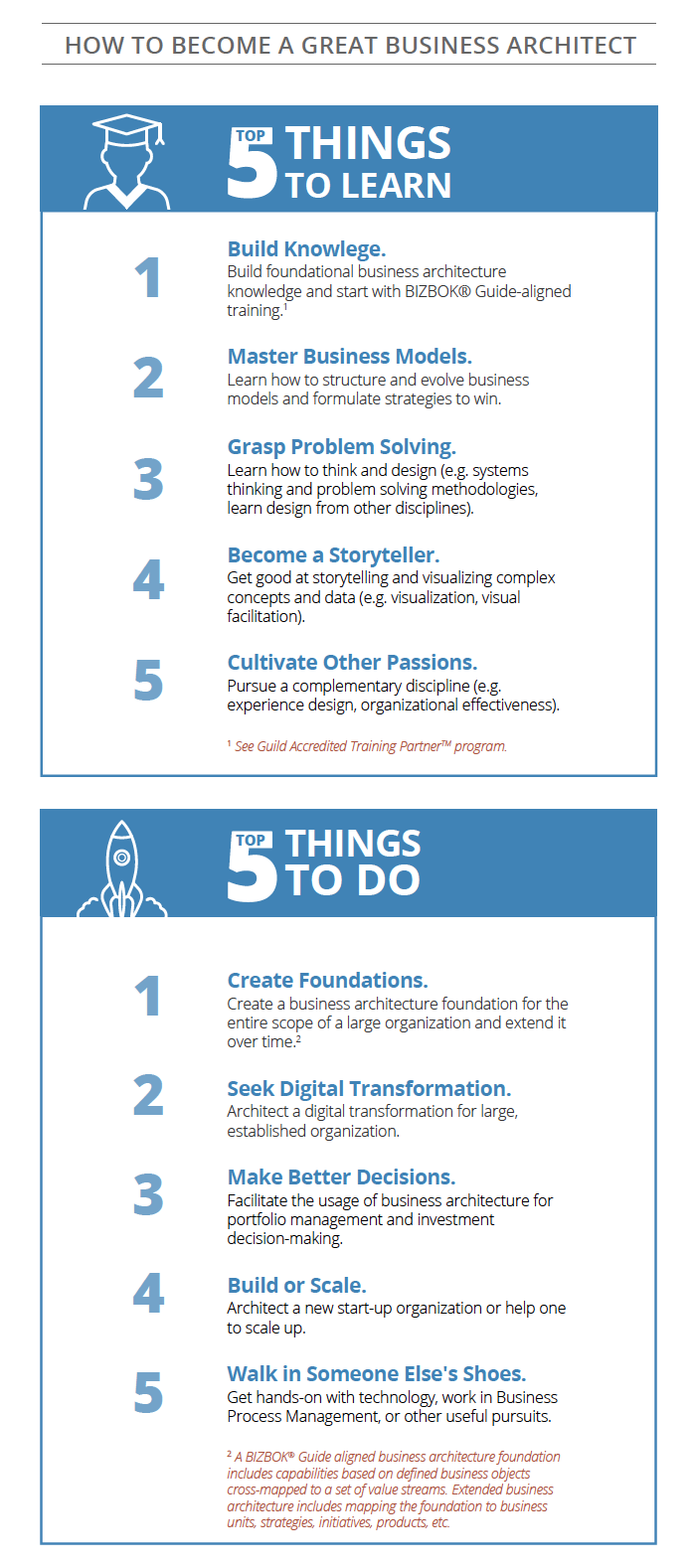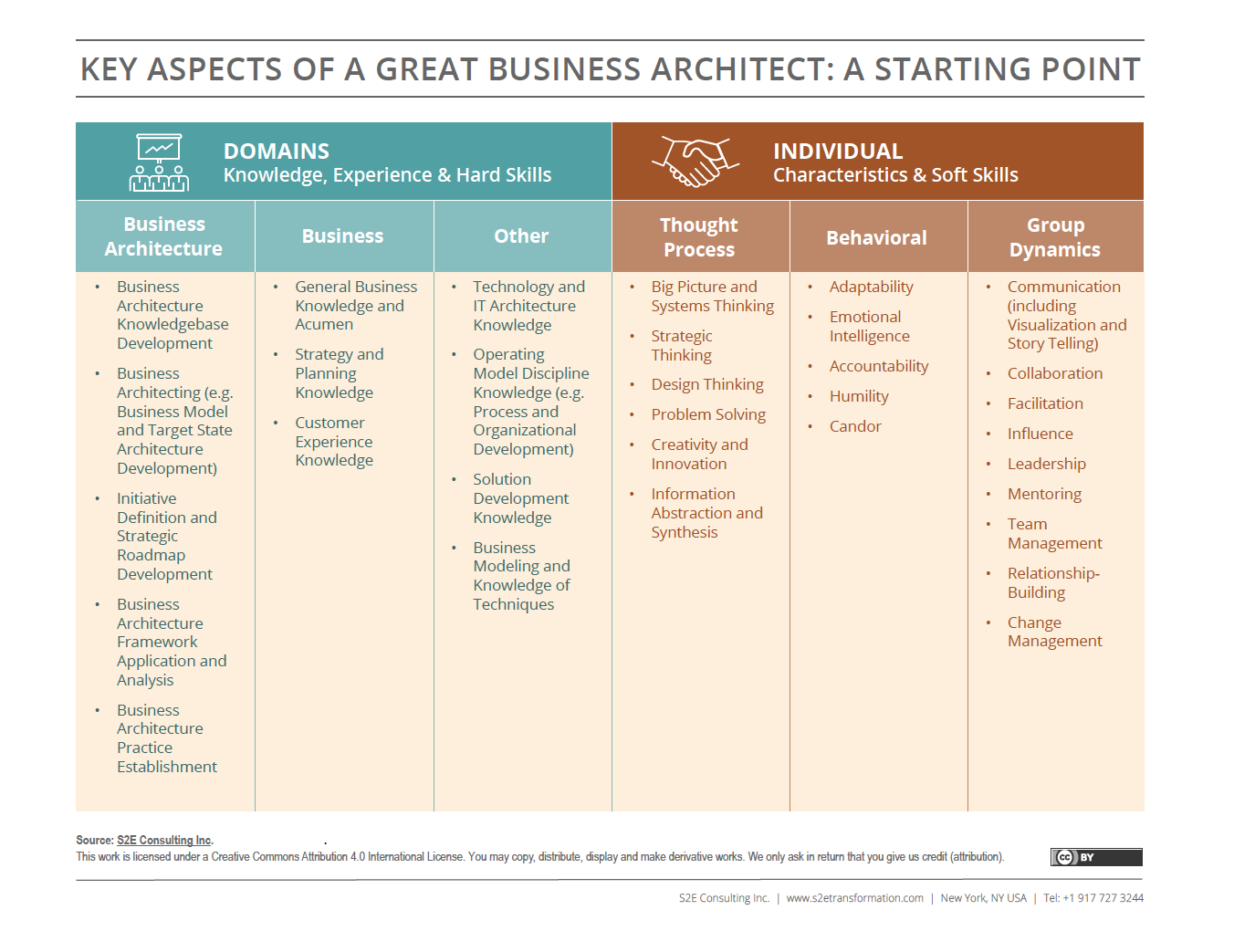![]() This installment of StraightTalk is a follow-on from our previous post on what makes a great business architect. Let’s get actionable on what we talked about last time.
This installment of StraightTalk is a follow-on from our previous post on what makes a great business architect. Let’s get actionable on what we talked about last time.
You had me at “business architect,” so how do I become a great one?
Here are some of the most important things you can learn to become a great business architect.
- Build foundational business architecture knowledge and start with BIZBOK® Guide-aligned training – It all starts here. First, you have to know how to build a business architecture.
- Learn how to structure and evolve business models and formulate strategies to win – Get deep here. If you aspire to be a trusted advisor to the business, you need to understand what makes organizations tick. Not to mention, this stuff is great fun.
- Learn how to think and design – Develop structured methods for thinking (e.g. systems thinking and problem-solving methodologies). Learn how to design, including from completely different perspectives (e.g. building architecture, biology, etc.).
- Get good at storytelling and visualizing complex concepts and data – Business architects are agents of change, so exceptional and compelling communication skills are important (e.g. visualization, visual facilitation).
- Pursue a complementary passion – Pick an elective. There are many complementary disciplines and techniques that are interesting to learn, such as experience design or organizational effectiveness, and they will only make you a more well-rounded, effective and happier business architect.
What else should I do?
Here are some of the most important things you can do to become a great business architect. There’s no substitute for doing, so raise your hand for these opportunities or make them for yourself.
- Create a business architecture foundation for the entire scope of a large organization and extend it over time – Build a business architecture from scratch by facilitating a cross-functional group of business representatives. Create an enterprise capability map based on defined business objects. Create a set of enterprise value streams. Cross-map the capabilities to value streams at the stage level. Now you have the foundation. Then, over time, capture additional business architecture domains (e.g. business units, strategies, initiatives, products, etc.) and other domains (e.g. system applications, processes, etc.) and cross-map them to the capabilities and value streams. And, use and live with what you created for a substantial amount of time.
- Architect a digital transformation – Building an organization’s business architecture is a necessary pre-requisite, but remember business architects architect—not just model. Signing up to architect a digital transformation is one of the most relevant things you can do at this point in time.
- Facilitate the usage of business architecture for portfolio management and investment decision-making – This isn’t “architecting” anything, but it is one of the most impactful common and impactful uses of business architecture.
- Architect a new start-up organization or help one to scale – The strategic thinking and urgency of a start-up will test your business architecting skills in a new way, especially if you work in a corporate environment now.
- Walk for a while in other pairs of shoes – Most great business architects come to the role with a rich set of prior career experiences, which is necessary for such a multi-faceted role. Get hands-on with technology. Work in a Business Process Management or data role. You get the idea.
Here’s all of that in a handy diagram for you.
Is certification important?
- Business Architecture Practitioners can solidify their knowledge of the BIZBOK® Guide and differentiate themselves to become more marketable for new job opportunities. (P.S. Remember to focus on the learning—not the letters after your name.)
- Organizations who support business architecture certification can more consistently define job descriptions and assess job candidates and employee performance. Certification is a great way to ensure that all business architects on the team actually know what you think they know. It creates a common frame of reference. Not to mention, happy employees = better retention.
- The Business Architecture Discipline can continue to advance and demonstrate growth, strength and relevancy. The stronger the discipline = the stronger your position as an individual business architect, so there is an argument to become certified for the greater good.
* See the Certified Business Architect (CBA®) program from the Business Architecture Guild.®
How can I grow as a business architect if my organization does not support me?
Invest in yourself, even if your organization does not yet believe in business architecture. They will when you start delivering value.
First, stay hungry. Never stop learning, exploring and trying.
Find yourself a business architecture mentor from within and/or outside of the organization.
Make up a project. Create one internally (you don’t need to advertise that you are “doing business architecture”). If that doesn’t work (or even if it does), create one externally. Do some architecting for a non-profit, small business, church or other organization. Getting experience + doing good at the same time = the ultimate combo.
Take control of your own career path and decide where you want to go and who you want to be. You can have a lifetime of interesting work and value to contribute in the business architecture discipline—and it is equally an excellent jumping off point for other roles and disciplines.
What else can I do?
Remember that there are things which have nothing to do with business architecture which will make you a better business architect—things that challenge you in new ways, broaden your perspective, give you more confidence and make you a better human. So take a sabbatical, go on a trek or volunteer some time where it’s needed. It all matters.
More Good Stuff…
Business Architecture Recommended Resources (S2E): Loads of business architecture and other related resources, just for you.
The Evolution of the Business Architect (Clark and Kuehn white paper): If you’re new to StraightTalk and haven’t seen this one yet, here’s a look at what the business architect role is and should be, and how you can take charge of your own career path.
Certified Business Architect (CBA)® Program: The level 1 CBA® certification currently available from the Business Architecture Guild® tests a practitioner’s knowledge of the BIZBOK® Guide. An additional level(s) of experience-based certification will be available in the future.
Guild Accredited Training ProgramTM (GATP®) Program: Find an accredited training partner whose training is BIZBOK® Guide-aligned.
Mental Models: The Best Way to Make Intelligent Decisions (109 Models Explained) (Farnam Street): Loads of mental models to help structure your thinking and decision-making.
Making Systems Thinking Sexy (TED Talk): A TED Talk by Eli Stefanski on systems-level thinking—critical to our world now—with social examples. Become an impatient optimist.



